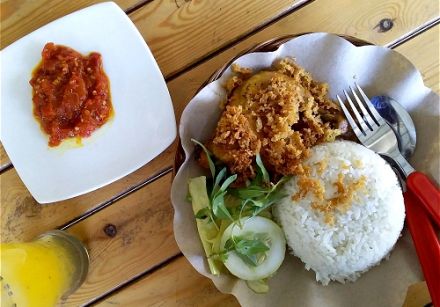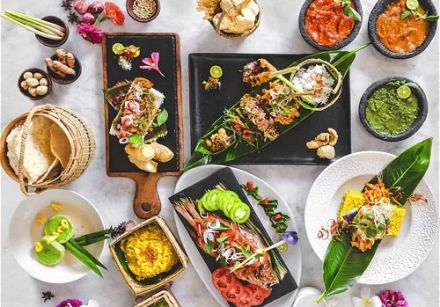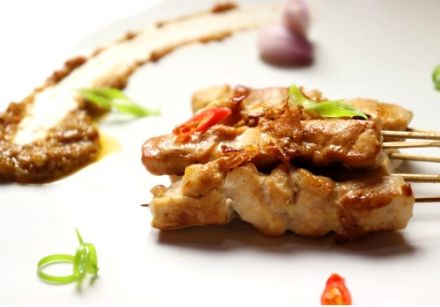 |
In Indonesia many eating traditions are related to social class and region. The Javanese and Balinese have Waroeng, a particular dining custom which takes place in their homes or in waroengs, simple traditional huts found in each village that serve as meeting places where the inhabitants can eat and talk together. This custom goes back several centuries to the days when the Hindu kingdom of the Majapahit still governed Java. When the Hindus were defeated and exiled to Bali in 1525, the tradition was carried with them. Today these waroengs are restaurants furnished with large tables and benches where people can gather for meals and discussion. The essential has not really changed.
Carrying on colonial tradition is the famous Grand Rijstaffel, which will satisfy all your gastronomic yearnings! This is an excellent way to experience the diversity of Indonesian cuisine. Go to one of the big hotels, such as the Tugu Bali, where you'll be presented with 12 different dishes, each brought by a different waiter according to tradition. Rijstaffel literally means "rice table" in Dutch. The meal consists of vegetables, meat, fish, eggs and poultry around a mountain of rice, garnished with krupuk (shrimp fritters), bananas, hot peppers, peanuts and pickles.
Wantilan is a gathering place after ceremonies, where people sit on the floor to share a meal called Megibung. A plate of yellow rice (scented with turmeric) is placed on the table in a large cone shape, the height of which indicates the diner's social standing.

Indonesian food is excellent and tasty, a showcase of the spices that constitute the country's main agricultural commodity. A subtle blend of Chinese, Malay and even Dutch influences, Indonesian cuisine is based on rice and noodles. They can be fried with meat and fish, combined with flavorful curries, or accompanied by tasty brochettes. The national dish is called nasi goreng, fried rice with finely chopped meat, shrimps and egg.
The food varies from island to island.
In Kalimantan, you can enjoy the biggest fresh water shrimp you've ever seen.
In Bali, enormous prawns and frog's legs from the rice paddies are a special treat.
Sumatra in general and the west coast around Padang in particular pride themselves on having the spiciest food in all of Indonesia. Nasi padang is a specially spiced rice dish, and deng deng is a meat dish generously seasoned with hot chilies.
In the Moluccas, sago replaces rice as the basic food. Obtained from the sago palm, the granular starch is boiled to make a paste that is then cooked into flat breads to accompany every dish.
Fresh fish is a specialty of Sulawesi, as are grilled pork and buffalo - the meat is grilled in bamboo poles and generously sprinkled with tuak (palm alcohol). Even more exotic are tikus (field rat) and paniki (fruit bat).
Desserts consist mostly of fresh fruits: mangos, little pink or yellow bananas, passion fruit, mandarin, anone, salak or snake fruit, covered with hard brown scales, and durian which gives off such a foul odor that it is prohibited on aircraft!

Imagine 74,505 square kilometers of islands separated from the Celebes by the sea of Banda and the Molucca Sea, right in the heart of Indonesia. On the seven main islands, crowned with volcanic peaks, three have passed into history. There are clove and nutmeg trees everywhere, growing like weeds. Dreams of ducats, florins and piastres are attached to every square foot of soil on this land blessed by the gods: fertile ground, but also a battlefield where blood was shed for the rights to these spices.
These days, spices and condiments impart their unique flavors to dishes: chilies, garlic, soy sauce, coconut, ground peanuts, ginger and a dozen other spices: the coveted seasonings that drew the first European traders to these islands. Peranakan cuisine was born from the fusion of Chinese cooking and Indonesian spices.
If you like your dishes spicy, ask for them "pedas." In some establishments they'll bring you a bottle of sambal, a chili paste flavored with shrimps and mixed with lime juice. Be careful: a drop or two adds a fiery heat.

For a quick bite to eat, there's nothing like the kakis limas (literally "five legs"): little mobile stalls where you can buy rice and soups that are kept hot over charcoal. Generally speaking, however, warung (inexpensive restaurants) or pasar malam (night markets) offer traditional dishes: ayam goreng (chicken with fried rice), bakmi (rice noodles), babur ayam (a sweet porridge of chicken and sticky rice or mung beans), gado gado (steamed bean sprouts and vegetables with spicy peanut sauce), or krupuk (shrimp and cassava flour fritters).
Keep in mind that the water is not potable, at least not for westerners. It must be boiled first. But beware - Indonesians tend to serve water that has been merely heated up. You have to ask for "medidih duapuluh menit," meaning water boiled for 20 minutes.

Lassi is a yogurt-based drink of Indian origin, appreciated by those who like fermented dairy drinks (dairy products are, in general, rare in this country.) Coffee (kopi) is made either from powder or from dried coffee particles that infuse directly in the cup or float on the surface. It's a local product. Fresh fruit juices are a particular treat.
Every afternoon before sundown, tea becomes a ritual… green, jasmine, ginger or chrysanthemum tea, served with little cakes (jajan pasar) and "forgotten fruits" (sauces or salads made from exotic fruit.) Ask for panas (hot tea); manis (sweet); pahit or tawar (without sugar); dingin (cold.)


Photos
Collaboration: Bali Tugu (hotel) and Kuoni travel agency
Spices: Club House for chefs
Tea Plantation: Indonesia travel

-

 Recipes
Recipes
-

 Products
Products
-

 Entertaining
Entertaining
-

 Chefs
Chefs
-

 Hints & Tips
Hints & Tips
-

 Glossaries
Glossaries








